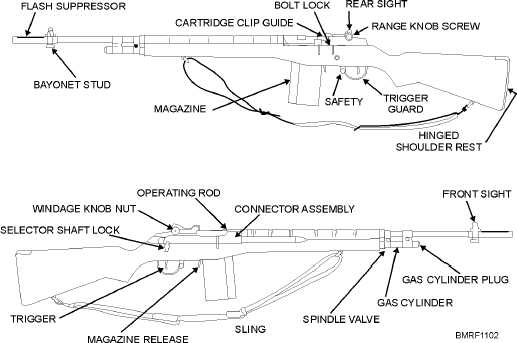designed to accommodate a 20-round magazine, the
M76 grenade launcher, and the M6 bayonet.
The overall length of the rifle (with a flash
suppressor) is 41.31 inches. The weapon has a muzzle
velocity of 2,800 feet per second and a maximum range
of 4,075 yards. Empty, the rifle weighs about 9 pounds.
Fully loaded and ready to fire, the rifle weighs about 11
pounds.
THE M16A1/A2 RIFLE
Learning Objectives: When you finish this chapter, you
will be able to—
Identify the differences between the M16A1 and
M16A2 rifles.
Recognize procedures to load and unload the
magazine.
I d e n t i f y p r o c e d u r e s f o r c l e a n i n g a n d
maintaining the M16A1 and M16A2 rifles.
The M16A1 and the M16A2 rifles (fig. 11-3 and fig.
11-4) are magazine-fed, gas-operated shoulder
weapons. They are chambered for a 5.56-mm (about
.22-caliber) cartridge. The magazine has a capacity of
20 or 30 rounds and may be loaded with any amount, up
to capacity. The caliber may seem small, but the bullet
has a muzzle velocity of more than 3,000 feet per second
and a muzzle energy of more than 13,000 foot-pounds.
A forward assist assembly, located on the right rear of
the upper receiver, permits the operator to ensure the
bolt is locked in the forward position. They have a
maximum effective range of 460 meters.
DIFFERENCE BETWEEN THE M16A1 AND
THE M16A2
The steps you take when field-stripping and
cleaning the M16A1 and M16A2 weapons are basically
the same. However, there are some major differences
between the two weapons. These differences include
the barrel, sights, selector assembly, ammunition, and
hand guards of the two rifles.
WARNING
Ensure you are using the proper ammunition
for the M16A1 and the M16A2. Improper use
may cause serious damage.
11-3
Student Notes:
Figure 11-2.—The 7.62-mm M14 rifle.


